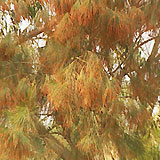She-oak
At certain times of the year and particularly in winter many she-oaks go reddish brown and look as if they are dying. Well, they aren’t necessarily dying indeed it is quite the opposite. The tree is actually flowering. She-oaks have separate ‘male’ and ‘female’ trees (known to botanists as dioecious), and the reddish brown colour is seen on male trees when they flower. The male flowers appear on the ends of the ‘needles’ in autumn and winter. Small, woody, cone-like fruit forms when female flowers are pollinated.
Another curious thing about she-oaks is that their needles, which you would think are leaves, are actually stems or branchlets. To reduce water loss, the leaves are reduced to tiny scales, which can be seen if you look closely at a she-oak needle.



